article In conversation with
Ilyas Kassam
In conversation with
Ilyas Kassam
Ilyas Kassam
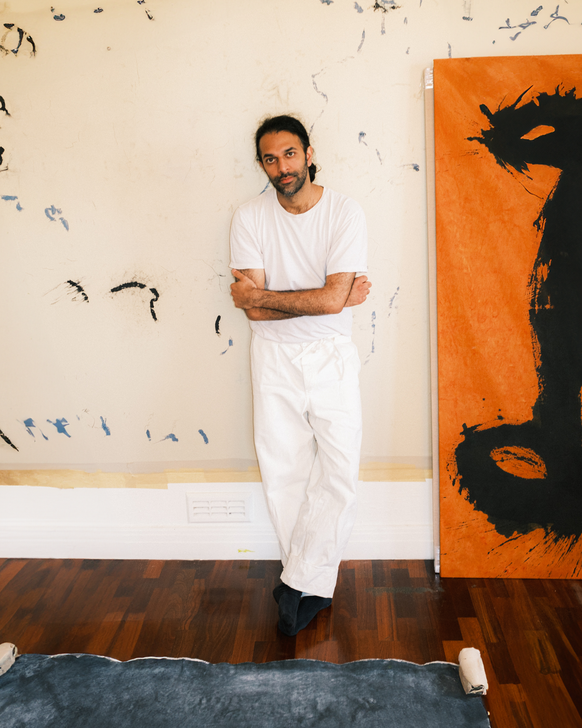
In conversation with Ilyas Kassam
about meditation, movement
and methods of artistic processing.
about meditation, movement
and methods of artistic processing.
In conversation with Ilyas Kassam
about meditation, movement
and methods of artistic processing.
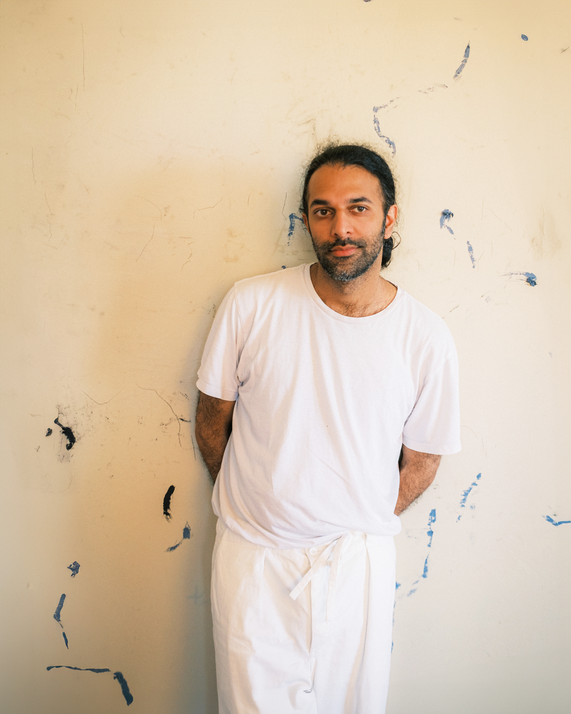
Ilyas Kassam is a UK based, Indian Ismaili Visual Artist and Poet. Drawing from Ismaili, Kufic, and Japanese calligraphic traditions, his works centres around the notion of infinity and the role language plays within the mystical experience. He is known for his large textual paintings on rice paper and canvas, that have an explosive yet meditative quality.
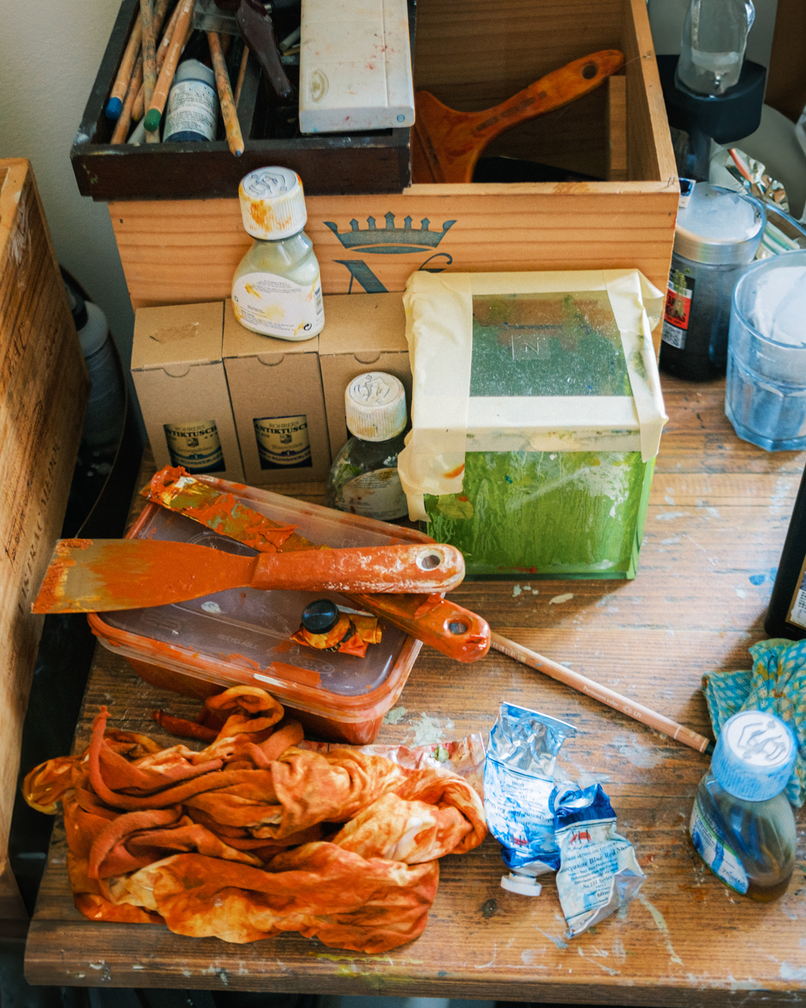
Artiq In both your art and poetry, you frequently engage with language in playful and unconventional ways, such as incorporating seemingly meaningless symbols in your artwork. This is particularly evident in a recent installation of yours. How do you hope viewers will interpret or respond to the asemic text within this piece?
Ilyas Despite language being an incredibly useful tool, it is also deeply connected to the sublime. There is a visceral, personal and immediate quality to a script, especially when handwritten. A word is an image, a sound, a movement, an energy, and holds a semantic, but in our everyday life the latter determines its meaning. I see words to be much more than this, I see them as alive; beings living and moving, receiving and evolving. As the natural movements of my body seem to reveal some propulsion towards the lexical, I have come to believe there is a somewhat scriptural quality to the universe, or codified plane of symbols that live amongst us, within in our bodies, our consciousness and our spaces. This playful approach to language opens possibilities, to unearth a poetic, where the linguistic is visual, and the visual is linguistic. The hope is that such works find some resonance with this scriptural quality within us; whilst a part us is challenged, curious and desirous to interpret the words, another part softens to the other layers of its form, opening to a deeper meaning that can be non-definitive and personal in its reception.
Ilyas Despite language being an incredibly useful tool, it is also deeply connected to the sublime. There is a visceral, personal and immediate quality to a script, especially when handwritten. A word is an image, a sound, a movement, an energy, and holds a semantic, but in our everyday life the latter determines its meaning. I see words to be much more than this, I see them as alive; beings living and moving, receiving and evolving. As the natural movements of my body seem to reveal some propulsion towards the lexical, I have come to believe there is a somewhat scriptural quality to the universe, or codified plane of symbols that live amongst us, within in our bodies, our consciousness and our spaces. This playful approach to language opens possibilities, to unearth a poetic, where the linguistic is visual, and the visual is linguistic. The hope is that such works find some resonance with this scriptural quality within us; whilst a part us is challenged, curious and desirous to interpret the words, another part softens to the other layers of its form, opening to a deeper meaning that can be non-definitive and personal in its reception.
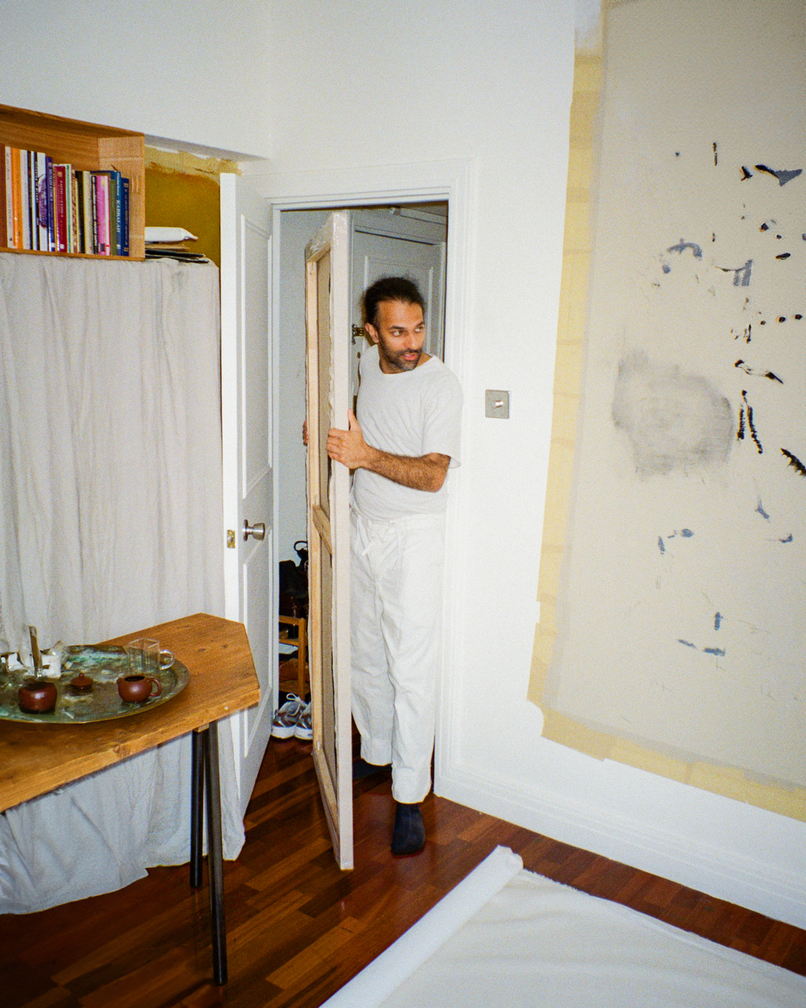
Artiq You have a quite a varied practice that has many references to the art history canon. How would you describe your art practice and how did these ideas inspire you?
Ilyas I see my practice as a practice of presence, a connection and devotion to the environment of oneself, and art making is a material expression of this. For me, the methodology has always lied in finding autonomic movements that emerge from the body. This impulse has resonance with movements like Abstract Expressionism, Actionism and Gutai, but is also rooted in my own Ismaili-Islamic heritage. The use of art and poetry as a transcendent means for connecting with the divine is embedded within the mystical tradition of Islam. I grew up in an Indian, Islamic household, educated in England, with parents born in Tanzania. Much of my life and practice has been about integrating these cultures within myself and allowing them to learn and grow from each other. When I paint, I see all the traditions of my lineage communing, and the intention is to enter into a state of unity and non-judgement. The use of the body allows for that place of integration, where listening is the governing force, allowing what arises to arise. These influences and methods of processing, have always been present in my life, but they began to inform an arts practice after I fell ill many years ago; it was at this point that I delved into philosophy, and engaged intellectually with Ismailism. This eventually led to a meditation and arts practice that sought to integrate these ideas in an embodied manner. It was through such a somatically engaged practice that I began to heal.
Ilyas I see my practice as a practice of presence, a connection and devotion to the environment of oneself, and art making is a material expression of this. For me, the methodology has always lied in finding autonomic movements that emerge from the body. This impulse has resonance with movements like Abstract Expressionism, Actionism and Gutai, but is also rooted in my own Ismaili-Islamic heritage. The use of art and poetry as a transcendent means for connecting with the divine is embedded within the mystical tradition of Islam. I grew up in an Indian, Islamic household, educated in England, with parents born in Tanzania. Much of my life and practice has been about integrating these cultures within myself and allowing them to learn and grow from each other. When I paint, I see all the traditions of my lineage communing, and the intention is to enter into a state of unity and non-judgement. The use of the body allows for that place of integration, where listening is the governing force, allowing what arises to arise. These influences and methods of processing, have always been present in my life, but they began to inform an arts practice after I fell ill many years ago; it was at this point that I delved into philosophy, and engaged intellectually with Ismailism. This eventually led to a meditation and arts practice that sought to integrate these ideas in an embodied manner. It was through such a somatically engaged practice that I began to heal.
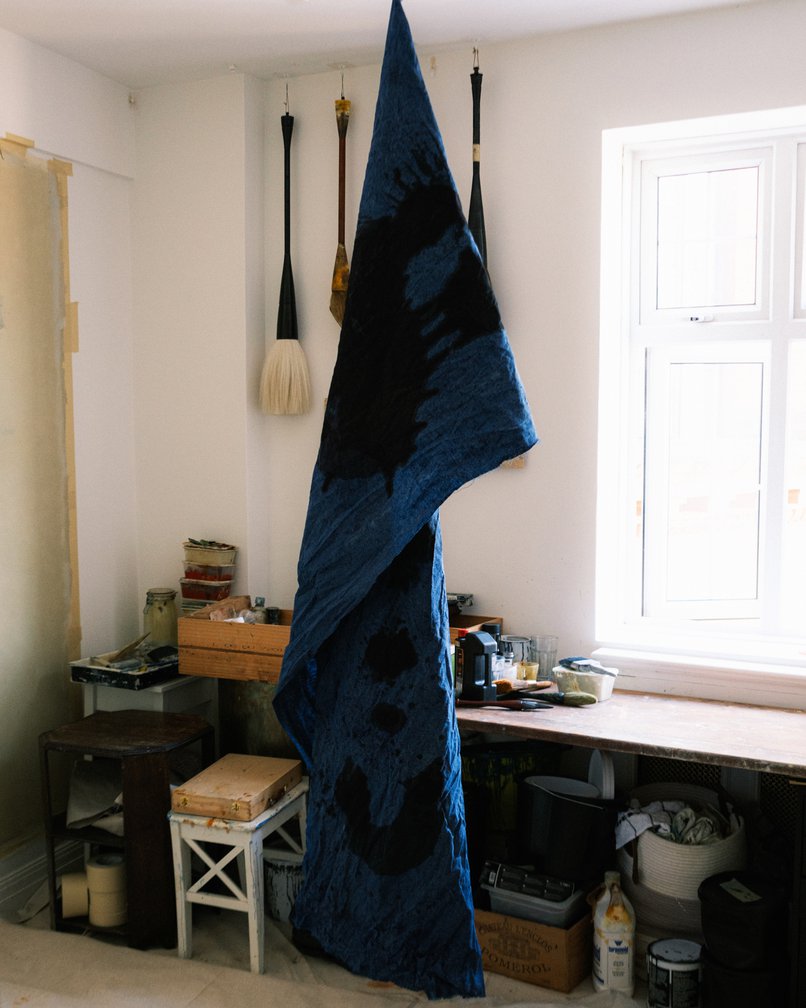
Artiq You have previously travelled to India and China to further your practice. How did you decide on these places and how did they impact your approach to your practice?
Ilyas Being Gujarati, India has always been an important place to me, but before going to Himachal Pradesh I hadn’t spent much time there. The intention around this experience was to heal. I was in a small mountain village meditating and walking. It was a solitary experience that cemented a consilience between art and spirituality, and a desire to pursue a life governed by this vital force.
My time in China was years later, once I had consolidated an arts practice. I was staying in a Qing Dynasty house, built for the then calligrapher of the region. I studied with the local calligrapher, and wandered the mountains making brushes from found materials. I have always had an affinity towards East Asian calligraphic traditions; an appreciation of the uncertain is reflected in the vitality of the materials and process, and a sense of a relational capacity with one’s materials rather than a subjugatory one. In this sense, I see a link between the spiritual and artistic traditions of India and China: a reverence for the natural and the transcendent through acknowledgement that the human is a vessel for the divine not an inhibitor of it.
These experiences altered the way I saw the world.
Ilyas Being Gujarati, India has always been an important place to me, but before going to Himachal Pradesh I hadn’t spent much time there. The intention around this experience was to heal. I was in a small mountain village meditating and walking. It was a solitary experience that cemented a consilience between art and spirituality, and a desire to pursue a life governed by this vital force.
My time in China was years later, once I had consolidated an arts practice. I was staying in a Qing Dynasty house, built for the then calligrapher of the region. I studied with the local calligrapher, and wandered the mountains making brushes from found materials. I have always had an affinity towards East Asian calligraphic traditions; an appreciation of the uncertain is reflected in the vitality of the materials and process, and a sense of a relational capacity with one’s materials rather than a subjugatory one. In this sense, I see a link between the spiritual and artistic traditions of India and China: a reverence for the natural and the transcendent through acknowledgement that the human is a vessel for the divine not an inhibitor of it.
These experiences altered the way I saw the world.
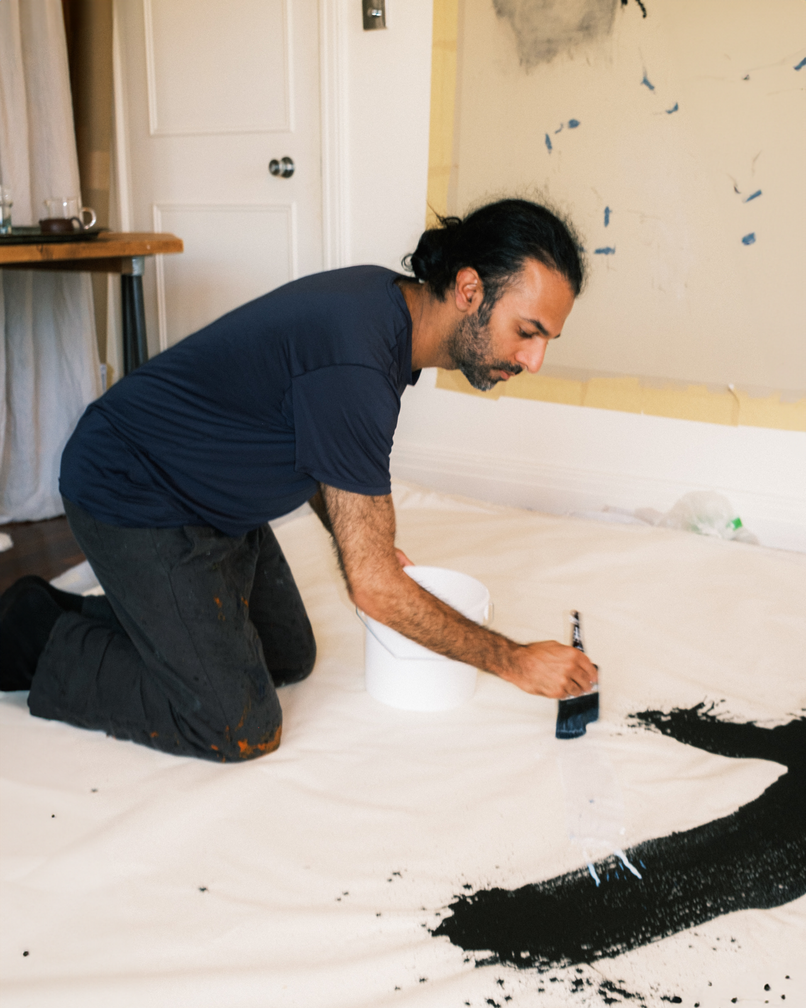
Artiq Could you speak more to your use on your body as a tool or brush to make your work?
Ilyas Most of my paintings begin with me lying on the canvas. Following a meditation, I start a movement practice that begins with creating folds and indentations in the canvas, progressing to the use of mark making tools to translate the movements of the body into more scriptural markings. Sometimes a brush is drawn across my body, sometimes I use my hair. The intention is to close the gap between feeling and expression, so that everything that happens is emergent and spontaneous. Using the body in this autonomic way allows for a very immediate and direct translation from energy into material.
The use of large weighty calligraphic brushes engages the whole body, forcing you to move with the brush. This inertia reduces your control, demanding you to respect the movements of the material and appreciate that you are in co-creative practice with your environment. In many ways I see this as a personal, contemporary continuation of Sufi practices such as Turning. The idea being to use the body to transcend the body, to aligns itself with the natural movements of the universe. Such a somatic approach has a healing effect, allowing energy to flow freely from the body, releasing the pressure of knowing and embracing the uncertain. The tranquil moment of clarity is what I wish to cultivate in myself and share with the world.
Ilyas Most of my paintings begin with me lying on the canvas. Following a meditation, I start a movement practice that begins with creating folds and indentations in the canvas, progressing to the use of mark making tools to translate the movements of the body into more scriptural markings. Sometimes a brush is drawn across my body, sometimes I use my hair. The intention is to close the gap between feeling and expression, so that everything that happens is emergent and spontaneous. Using the body in this autonomic way allows for a very immediate and direct translation from energy into material.
The use of large weighty calligraphic brushes engages the whole body, forcing you to move with the brush. This inertia reduces your control, demanding you to respect the movements of the material and appreciate that you are in co-creative practice with your environment. In many ways I see this as a personal, contemporary continuation of Sufi practices such as Turning. The idea being to use the body to transcend the body, to aligns itself with the natural movements of the universe. Such a somatic approach has a healing effect, allowing energy to flow freely from the body, releasing the pressure of knowing and embracing the uncertain. The tranquil moment of clarity is what I wish to cultivate in myself and share with the world.

Artiq You meditate before making your pieces. What do you feel this step of your practice helps you achieve?
Ilyas My practice is a way to connect to myself and to my environment, and the unusual intangible aspects of the world that miss our daily attention. It is a way to be present with what is, and to create through a process of listening rather than imagining. The moments of meditation help to centre myself in the moment, to feel into the materials and their desires, to hear the sounds of the space, and to say to thank you to the world for gifting me the opportunity to be here, doing this. The moment of painting can involve an extremely physical, often singular brushstroke, that emerges from a tension held or experienced within the body. This moment of meditation allows a space for such energies to emerge, in a way that ensures such a visceral expression is governed by a spirit of peace rather than violence.
Ilyas My practice is a way to connect to myself and to my environment, and the unusual intangible aspects of the world that miss our daily attention. It is a way to be present with what is, and to create through a process of listening rather than imagining. The moments of meditation help to centre myself in the moment, to feel into the materials and their desires, to hear the sounds of the space, and to say to thank you to the world for gifting me the opportunity to be here, doing this. The moment of painting can involve an extremely physical, often singular brushstroke, that emerges from a tension held or experienced within the body. This moment of meditation allows a space for such energies to emerge, in a way that ensures such a visceral expression is governed by a spirit of peace rather than violence.